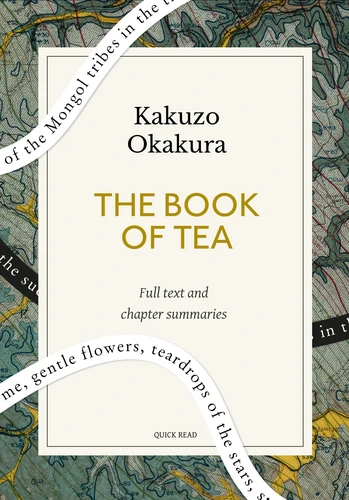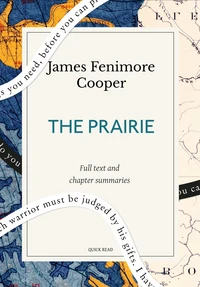The Book of Tea: A Quick Read edition
Par : ,Formats :
Disponible dans votre compte client Decitre ou Furet du Nord dès validation de votre commande. Le format Multi-format est :
- Pour les liseuses autres que Vivlio, vous devez utiliser le logiciel Adobe Digital Edition. Non compatible avec la lecture sur les liseuses Kindle, Remarkable et Sony
 , qui est-ce ?
, qui est-ce ?Notre partenaire de plateforme de lecture numérique où vous retrouverez l'ensemble de vos ebooks gratuitement
Pour en savoir plus sur nos ebooks, consultez notre aide en ligne ici
- FormatMulti-format
- ISBN978-2-38582-054-1
- EAN9782385820541
- Date de parution16/02/2024
- Protection num.NC
- Infos supplémentairesMulti-format incluant ePub sans ...
- ÉditeurQuick Read
Résumé
The Book of Tea is a long essay written by Okakura Kakuzo in 1906, which links the role of chado (teaism) to the aesthetic and cultural aspects of Japanese life. The book emphasizes how Teaism taught the Japanese many things, the most important of which were simplicity and humility. Okakura believed that this aesthetic should inform everything from the arts and architecture to daily life and was already informing them in Japan.
The book also discusses topics such as Zen and Taoism, but also the secular aspects of tea and Japanese life. According to Tomonobu Imamichi, Heidegger's concept of Dasein in Sein und Zeit was inspired by Okakura Kakuzo's concept of das-in-der-Welt-sein (being-in-the-worldness) expressed in The Book of Tea to describe Zhuangzi's philosophy. The Book of Tea has been cited as an important influence on the work of Frank Lloyd Wright, Arthur Wesley Dow, and Georgia O'Keeffe. Discover a new way to read classics with Quick Read. This Quick Read edition includes both the full text and a summary for each chapter. - Reading time of the complete text: about 2 hours - Reading time of the summarized text: 6 minutes
The book also discusses topics such as Zen and Taoism, but also the secular aspects of tea and Japanese life. According to Tomonobu Imamichi, Heidegger's concept of Dasein in Sein und Zeit was inspired by Okakura Kakuzo's concept of das-in-der-Welt-sein (being-in-the-worldness) expressed in The Book of Tea to describe Zhuangzi's philosophy. The Book of Tea has been cited as an important influence on the work of Frank Lloyd Wright, Arthur Wesley Dow, and Georgia O'Keeffe. Discover a new way to read classics with Quick Read. This Quick Read edition includes both the full text and a summary for each chapter. - Reading time of the complete text: about 2 hours - Reading time of the summarized text: 6 minutes
The Book of Tea is a long essay written by Okakura Kakuzo in 1906, which links the role of chado (teaism) to the aesthetic and cultural aspects of Japanese life. The book emphasizes how Teaism taught the Japanese many things, the most important of which were simplicity and humility. Okakura believed that this aesthetic should inform everything from the arts and architecture to daily life and was already informing them in Japan.
The book also discusses topics such as Zen and Taoism, but also the secular aspects of tea and Japanese life. According to Tomonobu Imamichi, Heidegger's concept of Dasein in Sein und Zeit was inspired by Okakura Kakuzo's concept of das-in-der-Welt-sein (being-in-the-worldness) expressed in The Book of Tea to describe Zhuangzi's philosophy. The Book of Tea has been cited as an important influence on the work of Frank Lloyd Wright, Arthur Wesley Dow, and Georgia O'Keeffe. Discover a new way to read classics with Quick Read. This Quick Read edition includes both the full text and a summary for each chapter. - Reading time of the complete text: about 2 hours - Reading time of the summarized text: 6 minutes
The book also discusses topics such as Zen and Taoism, but also the secular aspects of tea and Japanese life. According to Tomonobu Imamichi, Heidegger's concept of Dasein in Sein und Zeit was inspired by Okakura Kakuzo's concept of das-in-der-Welt-sein (being-in-the-worldness) expressed in The Book of Tea to describe Zhuangzi's philosophy. The Book of Tea has been cited as an important influence on the work of Frank Lloyd Wright, Arthur Wesley Dow, and Georgia O'Keeffe. Discover a new way to read classics with Quick Read. This Quick Read edition includes both the full text and a summary for each chapter. - Reading time of the complete text: about 2 hours - Reading time of the summarized text: 6 minutes























